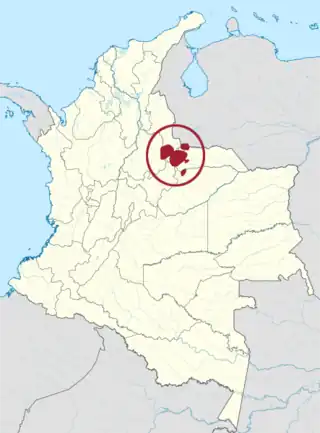Uwa language
The Uwa language, Uw Cuwa, commonly known as Tunebo, is a Chibchan language spoken by between 1,800 and 3,600 of the Uwa people of Colombia, out of a total population of about 7,000.[2]
| Uwa | |
|---|---|
| Tunebo | |
| Uw Cuwa | |
| Native to | Colombia, formerly in Venezuela |
| Region | the largest groups live on the northern slopes of the Sierra Nevada del Cocuy, Boyacá Department |
| Ethnicity | U'wa |
Native speakers | 3,550 (2000)[1] |
Chibchan
| |
| Language codes | |
| ISO 639-3 | Variously:tnd – Angosturas Tunebo/Bahiyakuwatbn – Barro Negro Tunebo (Eastern Tunebo/Yithkaya)tuf – Central Tunebo (Cobaría/Kubaru'wa & Tegría/Tagrinuwa)tnb – Western Tunebo (Aguas Blancas/Rikuwa) |
| Glottolog | tune1260 |
| ELP | Tunebo |
 | |
Varieties
There are half a dozen known varieties. Communication between modern varieties can be difficult, so they are considered distinct languages.
Adelaar (2004) lists the living
- central dialects Cobaría and Tegría on the northern slopes of the Sierra Nevada del Cocuy,
- a western group near Agua Blanca in the departments of Santander and Norte de Santander,
- an eastern group at a place called Barro Negro in the lowlands of Arauca and Casanare,
- and the extinct dialect Sínsiga near Chita, Boyacá.
Umaña (2012) lists Cobaría, Tegría, Agua Blanca, Barro Negro.
Berich lists the dialects Cobaría; Agua Blanca (= Uncasía, Tamarana, Sta Marta); Rinconada, Tegría, Bócota, & Báchira
Cassani lists Sínsiga, Tegría, Unkasía (= Margua), Pedraza, Manare, Dobokubí (= Motilón)
Osborn (1989) lists
- Bethuwa (= Pedraza, extinct),
- Rikuwa (Dukarúa, = Agua Blanca),
- Tagrinuwa (Tegría),
- Kubaruwa (Cobaría),
- Kaibaká (= Bókota),
- Yithkaya (= San Miguel / Barro Negro),
- Bahiyakuwa (= Sínsiga),
- Biribirá,
- and Ruba,
the latter all extinct
Fabre (2005) lists:
- Bontoca (perhaps the same as the Bókota = Kaibaká cited in Osborn), of the mountains of Guican
- Cobaría, along the Cobaría River
- Pedraza or Bethuwa [= Angosturas?], along the Venezuelan border; extinct
- Sínsiga, in the Guican mountains, recorded from Chita, Boyaca in 1871
- Tegría or Tagrinuwa, along the Cobaría River
- Unkasia, along the Chitiga and Marga rivers (Telban 1988)
Additional names in Loukotka are Manare and Uncasica (presumably a spelling variant of Unkasía/Uncacía), as well as Morcote, of which nothing is known. Manare, at the source of the Casanare, is Eastern Tunebo.
Phonology
Notes
- Angosturas Tunebo/Bahiyakuwa at Ethnologue (19th ed., 2016)

Barro Negro Tunebo (Eastern Tunebo/Yithkaya) at Ethnologue (19th ed., 2016)
Central Tunebo (Cobaría/Kubaru'wa & Tegría/Tagrinuwa) at Ethnologue (19th ed., 2016)
Western Tunebo (Aguas Blancas/Rikuwa) at Ethnologue (19th ed., 2016)
- Adelaar & Muysken (2004:109)
References
- Adelaar, Willem F. H.; Muysken, Pieter C. (2004). The Languages of the Andes. Cambridge University Press.
- Alain Fabre, 2005. Diccionario etnolingüístico y guía bibliográfica de los pueblos indígenas sudamericanos.
- Edna R. Headland, 1994. Diccionario Bilingüe Tunebo-Español, Español-Tunebo con una breve gramática tuneba. Ann Arbor: UMI.